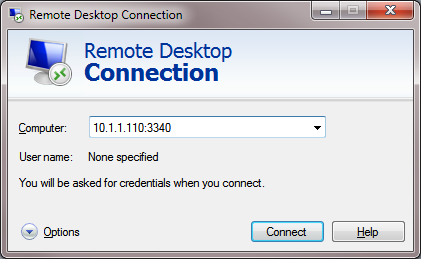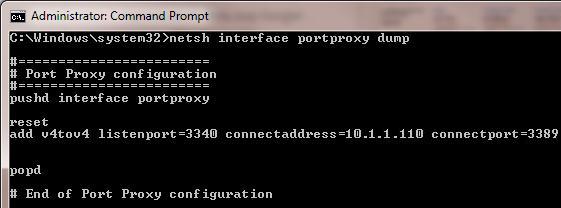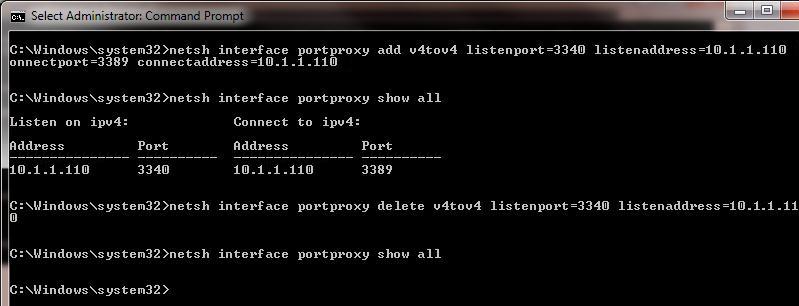Netsh Port Forwarding in Windows
2015-05-07 17:13
302 查看
In Microsoft Windows, starting from Windows XP, there is a built-in ability to set up network ports forwarding (port forwarding). Due to it, any connection coming to any port can be forwarded to another local port
or even to port on remote computer. Not necessarily that the system has a service listens on this port.
Port forwarding in Windows can be configured using Portproxy mode of the command Netsh. The syntax of this command is as follows:
where
listenaddress is a local ip address waiting for a connection
listenport listening port (the connection is waited on it)
connectaddress is an IP address or DNS name to which the connection will be forwarded
connectport is a TCP port to which the connection from listenport is forwarded to
Suppose, that our task is to make the RDP service to respond on a non-standard port, for example 3340 (the port can be changed in the settings of the service, but we will use RDP to make it easier to demonstrate forwarding).
Start the command prompt as an administrator and perform the following command:

Using netstat make sure that port 3340 is listened now

You can find out what process is listening to this port use its PID (in our example, the PID is 336):
Let’s try to connect to this computer from a remote system using any RDP client. Port 3340 should be specified as the RDP port. (It is specified after the column following the RDP server address):

The connection should be established successful.
Important. Make sure that your firewall (Windows Firewall or a third-party one that are often included into an antivirus software) allows incoming connections to the new port. If necessary, you can add a new Windows
Firewall rule using this command:
Display the list of forwarding rules in the system:
In our case there is only one forwarding rule from port 3340 to 3389:
Tip. Also, portproxy settings can be obtained as follows:

To remove a forwarding rule:

To clear all current forwarding rules:
Important. This forwarding scheme works only for TCP ports. You won’t be able to forward UDP ports this way. Also you can’t use 127.0.0.1 as connectaddress.
If you wont to forward an incoming TCP connection to another computer, the command can look like this:
This rule forwards all incoming RDP requests to the IP address 192.168.100.101
Another portproxy feature is an opportunity to make it look like any remote network service is operating locally.
For example, forward the connection from the local port 5555 to the remote address 157.166.226.25 (CNN website):
Now if you go to http://localhost:5555/ in your browser, CNN Start page will open. So despite the browser addresses the local computer, it opens a remote
page.

Port forwarding can also be used to forward a port from an external address of a network card to a virtual machine port running on the same computer.
or even to port on remote computer. Not necessarily that the system has a service listens on this port.
Port forwarding in Windows can be configured using Portproxy mode of the command Netsh. The syntax of this command is as follows:
netsh interface portproxy add v4tov4 listenaddress=localaddress listenport=localport connectaddress=destaddress connectport=destport
where
listenaddress is a local ip address waiting for a connection
listenport listening port (the connection is waited on it)
connectaddress is an IP address or DNS name to which the connection will be forwarded
connectport is a TCP port to which the connection from listenport is forwarded to
Suppose, that our task is to make the RDP service to respond on a non-standard port, for example 3340 (the port can be changed in the settings of the service, but we will use RDP to make it easier to demonstrate forwarding).
Start the command prompt as an administrator and perform the following command:
netsh interface portproxy add v4tov4 listenport=3340 listenaddress=10.1.1.110 connectport=3389 connectaddress=10.1.1.110

Using netstat make sure that port 3340 is listened now
netstat -ano | findstr :3340

You can find out what process is listening to this port use its PID (in our example, the PID is 336):
tasklist | findstr 336
Let’s try to connect to this computer from a remote system using any RDP client. Port 3340 should be specified as the RDP port. (It is specified after the column following the RDP server address):

The connection should be established successful.
Important. Make sure that your firewall (Windows Firewall or a third-party one that are often included into an antivirus software) allows incoming connections to the new port. If necessary, you can add a new Windows
Firewall rule using this command:
netsh advfirewall firewall add rule name=”RDP_3340” protocol=TCP dir=in localip=10.1.1.110 localport=3340 action=allow
Display the list of forwarding rules in the system:
netsh interface portproxy show all
In our case there is only one forwarding rule from port 3340 to 3389:
Listen on ipv4: Connect to ipv4: Address Port Address Port --------------- ---------- --------------- ---------- 10.1.1.110 3340 10.1.1.110 3389
Tip. Also, portproxy settings can be obtained as follows:
netsh interface portproxy dump
#======================== # Port Proxy configuration #======================== pushd interface portproxy reset add v4tov4 listenport=3340 connectaddress=10.1.1.110 connectport=3389 popd # End of Port Proxy configuration

To remove a forwarding rule:
netsh interface portproxy delete v4tov4 listenport=3340 listenaddress=10.1.1.110

To clear all current forwarding rules:
netsh interface portproxy reset
Important. This forwarding scheme works only for TCP ports. You won’t be able to forward UDP ports this way. Also you can’t use 127.0.0.1 as connectaddress.
If you wont to forward an incoming TCP connection to another computer, the command can look like this:
netsh interface portproxy add v4tov4 listenport=3389 listenaddress=0.0.0.0 connectport=3389 connectaddress=192.168.100.101
This rule forwards all incoming RDP requests to the IP address 192.168.100.101
Another portproxy feature is an opportunity to make it look like any remote network service is operating locally.
For example, forward the connection from the local port 5555 to the remote address 157.166.226.25 (CNN website):
netsh interface portproxy add v4tov4 listenport=5555 connectport=80 connectaddress= 157.166.226.25 protocol=tcp
Now if you go to http://localhost:5555/ in your browser, CNN Start page will open. So despite the browser addresses the local computer, it opens a remote
page.

Port forwarding can also be used to forward a port from an external address of a network card to a virtual machine port running on the same computer.
相关文章推荐
- Methods Collection of Enumerating Com Port in Windows, by C
- How To Set Up Port Forwarding in Linux
- How to use Serial Port in Windows
- Windows Serial Port Programming in C.
- Seeking USB Serial Com Port in Windows Automatically : via PID VID
- windows下Eclipse启动tomcat提示port已被占用 already in use
- Seeking USB Serial Com Port in Windows Automatically : via PID VID
- SQLite Practice Using C# in Windows
- UARs For The Cycle Bin In Windows-4
- Make Cool Use of Windows Remote Desktop In XP
- chromiumembedded - A simple framework for embedding chromium browser windows in other applications. - Google Project Hosting
- Auto-Start Programs Config in Windows
- Working with Windows Workflow Foundation in ASP.NET
- Introducing Windows Communication Foundation in .NET Framework 4
- First Look: New Security Features in Windows Vista
- Order of Events in Windows Forms——Windows Foms 事件加载顺序
- java.rmi.server.ExportException: Port already in use : 9898;
- manual make usb installer for windows in ubuntu15.04
- Error was Port already in use: 40001
